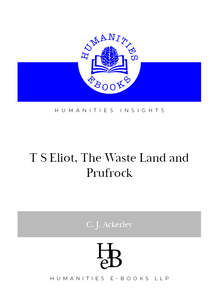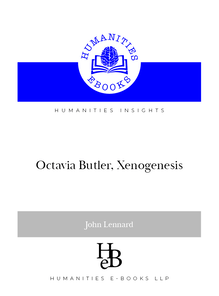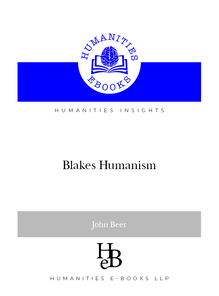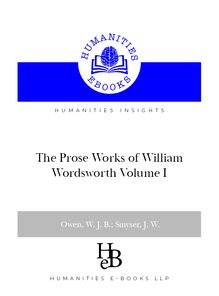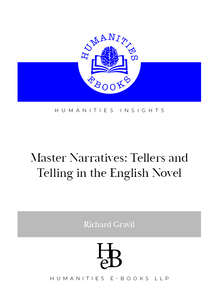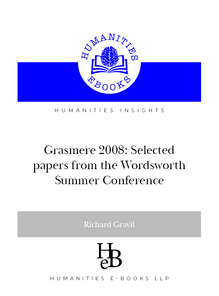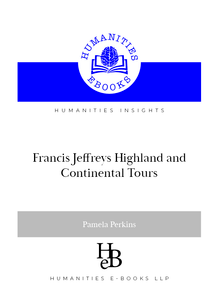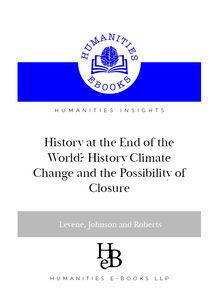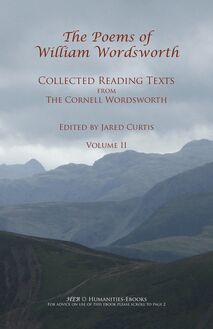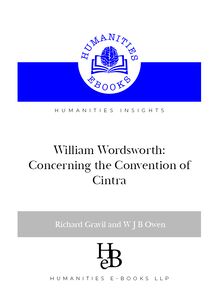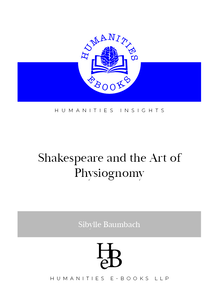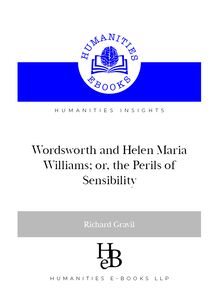-
 Univers
Univers
-
 Ebooks
Ebooks
-
 Livres audio
Livres audio
-
 Presse
Presse
-
 Podcasts
Podcasts
-
 BD
BD
-
 Documents
Documents
-
- Cours
- Révisions
- Ressources pédagogiques
- Sciences de l’éducation
- Manuels scolaires
- Langues
- Travaux de classe
- Annales de BEP
- Etudes supérieures
- Maternelle et primaire
- Fiches de lecture
- Orientation scolaire
- Méthodologie
- Corrigés de devoir
- Annales d’examens et concours
- Annales du bac
- Annales du brevet
- Rapports de stage
La lecture à portée de main
118 pages
English
Découvre YouScribe en t'inscrivant gratuitement
Je m'inscrisDécouvre YouScribe en t'inscrivant gratuitement
Je m'inscris
Obtenez un accès à la bibliothèque pour le consulter en ligne
En savoir plus
En savoir plus
118 pages
English
Obtenez un accès à la bibliothèque pour le consulter en ligne
En savoir plus
En savoir plus

Description
Prufrock' is as fresh today as when it was first written, and, for better or worse, The Waste Land remains the celebrated poem of its age, a text that may be venerated, despised, rejected or enjoyed, but not ignored.
Sujets
Informations
| Publié par | Humanities eBooks |
| Date de parution | 11 janvier 2021 |
| Nombre de lectures | 0 |
| EAN13 | 9781847600158 |
| Langue | English |
| Poids de l'ouvrage | 1 Mo |
Informations légales : prix de location à la page 0,0250€. Cette information est donnée uniquement à titre indicatif conformément à la législation en vigueur.
Extrait
Literature Insights
T. S. Eliot‘The Love Song of J. Alfred Prufrock’ andThe WasteLand
by C. J. Ackerley
‘He do the police in different voices’ http//www.humanities-ebooks.co.uk
PublicationData
© C. J. Ackerley, 2007
The Author has asserted his right to be identiIed as the author of this Work in accordance with the Copyright, Designs and Patents Act 1988.
Published byHumanities-Ebooks.co.uk Tirril Hall, Tirril, Penrith CA10 2JE
ReaDingoPtions
*To navigate through the contents use the hyperlinked ‘Bookmarks’ at the left of the screen. *For ease of reading, use <CTRL+L> to enlarge the page to full screen *Use <Esc> to return to the full menu. *Hyperlinks appear in Blue Underlined Text. To return from a hyperlink use the ‘previous view’ button.
licenceanDPeRmissions
This book is licensed for perosnal use on any computer belonging to the pur-chaser. Making a copy for a third person woudl be an infringement of copy-right. High resolution printing is enabled.
isbn 978-1-84760-015-8
A Note on the Author
Chris Ackerley took his BA and MA at the University of Canterbury, New Zealand, and his PhD at the University of Toronto. He has taught at the University of Otago, New Zealand, since 1976, and was Head of Department 2001–03. His speciality is annotation, particularly of the works of Malcolm Lowry and Samuel Beckett. His books include:A Companion to ‘Under the Volcano’(Vancouver: UBC Press, 1984); Demented Particulars: The Annotated ‘Murphy’(1998; 2nd ed., rev. Tallahassee, FL: Journal of Beckett Studies Books, 2004);The Grove Companion to Samuel Beck-ett, with S.E. Gontarski (Tallahassee, FL: Journal of Beckett Studies Books, 2005); republished asThe Faber Companion to Samuel Beckett(London: Faber & Faber, 2006); andObscure Locks, Simple Keys: The Annotated ‘Watt’) (Tallahassee, FL: Journal of Beckett Studies Books, 2005).
Contents
A Note on the Author
Part 1: Before The Waste Land
1.1 Eliot’s Life and Works 1.2 Reading Eliot 1.3 The Music of Ideas
Part 2: ‘The Love Song of J. Alfred Prufrock’
2.1 ‘Prufrock’ 2.2 From ‘Prufrock’ toThe Waste Land
Part 3:The Waste Land:Preliminaries
3.1 The Role of Ezra Pound 3.2 The Dramatic Consciousness 3.3 The Mythic Consciousness 3.4 The Epigraph
Part 4: A Commentary onThe Waste Land
4.1 The Burial of the Dead 4.2 A Game of Chess 4.3 The Fire Sermon 4.4 Death by Water 4.5 What the Thunder Said
Part 5: Bibliography
5.1 Selected Works by Eliot (of relevance toThe Waste Land) 5.2 Background Works 5.3 Biographies 5.4 Critical Works
Part 6: Hyperlinked texts: key works inThe Waste Land
And I am accustomed to more documentation; I like to know where writers get their ideas from...
—Charles Augustus Conybeare, 1 The Carlton Club, Liverpool.
1 Otherwise T. S. Eliot, writing inThe Egoist(December 1917).
Part 1: BeforeThe Waste Land
1.1 Eliot’s Life and Works
Thomas Stearns Eliot was born in St Louis on 26 September 1888. His father, Henry Ware Eliot, a successful businessman and an executive of the Hydraulic-Press Brick Company, married in 1860 Charlotte Champe Stearns, a woman with literary inten-tions who wrote a biography of Eliot’s grandfather, William Greenleaf Eliot and a dra-matic poem about Savonarola. The family had New England and Unitarian connec-tions (both are manifest in Eliot’s early writing). The young Tom Eliot was schooled at Smith Academy, St Louis, and the Milton Academy, Massachusets, before enroll-ing at Harvard in 1906, where he took his Master’s degree (1910) in philosophy. That year he began the ‘The Love-Song of J. Alfred Prufrock’, which remained pub-lished until 1915. In 1911 Eliot went to the Sorbonne, Paris, where he met a young Frenchman named Jean Verdenal; then he returned to Harvard where he studied Sanskrit and furthered his love of French poetry as he began a doctoral dissertation on F. H. Bradley, author ofAppearance and Reality, a text that exercised consider-able influence on his thought. In 1914, Eliot was awarded the Sheldon Fellowship in philosophy, which gave him a year in England. He visited Marburg, Germany, that summer, but the outbreak of war forced him back to Merton College, Oxford, where he continued his studies before making three crucial decisions (each encouraged by Ezra Pound): to forsake philosophy for poetry; to marry Vivien Haigh-Wood; and to settle in England. Each proved momentous: Eliot would become the spokesman for the disillusion of a post-War generation; the marriage to Vivien would be a defining feature of his life, her neuralgia, insomnia and menstrual problems meeting his highly-strung con-sciousness and sexual fastidiousness; and he would become a quintessentially English voice and the most respected poet of his age. Partly in reaction to his marriage Eliot began to seek his personal and cultural consolation in Christianity, finally becom-ing, in his words, ‘classicist in literature, royalist in politics, and anglo-catholic in
‘Prufrock’ andThe Waste Land 7
1 religion’. These matters found expression inThe Waste Land; it remains a moot (but crucial) question as to how obvious or latent that expression might be. Eliot’s position in the years leading up that poem was precarious. Because of the war, he was unable to defend his Harvard thesis. To support his new life he took a position, first, as a teacher at High Wycombe Grammar School and later (March 1917) as a clerk at Lloyds Bank, where he remained until 1925, resisting Pound’s well-intentioned but impractical intentions of ‘rescuing’ him from that fate. Like Wallace Stevens, Eliot preferred to combine his vocation as a poet with a sedentary job. In 1922 he foundedThe Criterion, a conservative cultural periodical that was from 1925 sponsored by the publishing firm of Faber & Gwyer (soon Faber & Faber), which Eliot joined that year and of which he eventually became a director. Eliot’s new life is not the subject of this study, yet the difficult years between ‘Prufrock’ andThe Waste Landwere the matrix out of which his later writing was born. ‘The Hollow Men’ and ‘Ash-Wednesday’ trace the trajectory of his increasing attraction to the religious life, as reflected in his conversion to Anglicanism in 1927 and his abandonment of Vivien in the early 1930s, a decision that haunted him like 2 the memory of a sojourn in hell, no matter how he might justify it privately in terms of an Aeneas who must abandon his Dido to fulfil a greater spiritual duty. The public vindication of the religious vocation resides less in the controversial and intoler-ant essays of the 1930s on religion, culture and literature than the verse drama from Murder in the Cathedral(1935) toThe Elder Statesman(1953) and the poetry that many consider his masterpiece, theFour Quartets(1935–42).
1.2 Reading Eliot
If Eliot’s critical standing has had its ups and downs and has recently settled with less than the gilt-edged status it once enjoyed, ‘Prufrock’ is as fresh today as when it was first written, and, for better or worse,The Waste Landremains the celebrated poem of its age, occupying a position similar to James Joyce’sUlysses(fiction) and Samuel Beckett’sWaiting for Godot(drama), as a text that may be venerated, despised, rejected or enjoyed, but not ignored. Eliot expressed exasperation at its fame, more than once dismissing it as a piece of rhythmical grumbling; but the poem consolidated the revo-lution in poetry that he and Pound had initiated, making him in effect the arbiter of elegance of his age and placing him at the centre of London literary society, much as
1 T. S. Eliot, Preface toFor Lancelot Andrewes(London: Faber & Faber, 1928), 7. 2 Lyndall Gordon,Eliot’s New Life(Oxford: Oxford University Press, 1988), 3.
‘Prufrock’ andThe Waste Land 8
Matthew Arnold had been in his. Even so, the ways of reading Eliot’s poetry remain unsettled. IsThe Waste Land, for instance, a Modernist text, to be read according to the cultural principles of its own age and/or Eliot’s own critical, musical and aesthetic principles? Or is it better approached from a post-Derridean perspective, affirming the dialogic imagination and permissive meaning? A Modernist (centripetal) reading might stress coherence, seeking the unity of a fragmented discourse, a voice behind the different voices; a post-Modernist (centrifugal) reading could celebrate the diversity of tone and voice, the impulse to fragmentation and a tradition in tatters. And if Eliot finally reconciled these antithetical impulses in his vision of a Christian society, what does that imply for us? Equally, shouldThe Waste Landbe read strictly in its own terms (whatever those are), or as a prelude to the works that follow but were not then conceived? The poem in isolation seems one thing; but read as an interrupted pilgrimage towards the new life (as Lyndall Gordon has defined Eliot’s impulse towards Anglicanism) it appears as something else. And there remains the vexed question of personality: Eliot’s poetry embodies a central paradox, that of the author’s insistence on poetic impersonality even as his verse encapsulates the most harrowing personal feelings and presents the most agonizing images of the individual mind. The critical tradition reflects these dilemmas. The poem was at first typically seen as powerful but incoherent, yet the accompanying notes suggested a ‘plan’. New Critics, such as Cleanth Brooks, stressed its structural, thematic and poetic integrity, and (their lasting legacy) insisted on high standards of close reading even as they celebrated its allusive and ambiguous qualities. But as New Criticism faded, new paradigms (structuralist, post-structuralist, New Historicist, deconstructive, feminist, psycho-analytic) offered different readings that stress ‘absences’, ‘ruptures’ and ‘dis-continuities’. In his excellent survey of this process, Lawrence Rainey concludes that the demise of critical consensus about the poem means that today, more than ever, 3 questions of coherence are open to fresh interrogation. To be sure, Eliot when writing the early poems could not have imagined the intense scrutiny that they would receive, and there is thus in his later critical writ-ing an element of defence against too much prying into the personal life behind the verse. Eliot retained a deep wish for privacy. In ‘Tradition and the Individual Talent’ (1919), he insisted on the rigorous separation of the man who suffers from the mind that creates; and eight years later, in ‘The Stoicism of Seneca’ (1927), he argued that
3 Lawrence Rainey,The Annotated Waste Land with Eliot’s Contemporary ProseHaven & (New London: Yale University Press, 2005), 19.
‘Prufrock’ andThe Waste Land 9
the poet’s business is ‘to transmute his personal and private agonies into something rich and strange’. Eliot’s insistence on impersonality has discouraged many readers from seeing the poem in personal terms; equally, some biographical readings fail to distinguish between events in Eliot’s life and their representation in his poetry. One must take a stand. In what follows I attempt to reconcile the key issues of coherence/discontinuity and impersonal/personal with an approach to the purpose that seeks order (yet admits chaos) by reading it in much the way that ‘Prufrock’ might be read, as a dramatic monologue. That is, I seek a middle ground between seeing the poetry as essentially impersonal and/or regarding it as an ‘exorcism of 4 the demons’; and I do so by relating the imagery not to the referential world but to an implied speaker or mediator. This is easily done with ‘Prufrock’ and ‘Portrait of a Lady’ where the influence of Robert Browning is discernible if interiorised (as in the fiction of Henry James); and ‘Gerontion’, where the persona is identified.The Waste Land, infinitely more complex in its orchestration, may yet be seen as a dramatic poem that evokes from the outset a depressed state of mind and follows it through the stages of a partial recovery. In other words, I assume forThe Waste Landas for the other poems a coherent structure of discourse, with a central consciousness unit-ing the various parts; in what follows I refer to this construct as ‘the protagonist’ or ‘the poet’ (as distinct from Eliot himself), and unlike some commentators I do not identify that consciousness with Tiresias. If this is an essentially modernist perspec-tive, emphasising a mediating awareness rather than a fragmented vision, I can only affirm the need for such visions and revisions in a post-post-Modernist age. And there is a pragmatic purpose in so doing: even if my reader finally disagrees (as many will) with this emphasis, the fiction of coherence at least offers a framework to permit a close scrutiny of the particulars of the poem and the allusive and musical qualities that (on any reading) are its constitutive elements.
Question: does the definition of the poem as ‘dramatic’ resolve the oppositions noted: the ‘personal’ vs ‘impersonal’ and the ‘centrifugal’ vs ‘centripetal’ readings? Is the ‘dramatic’ a genuine critical option, or a structure of convenience?
4 James E. Miller, Jr.,T. S. Eliot’s Personal Waste Land: Exorcism of the Demons(University Park & London: Pennsylvania University State Press, 1977) is an extreme instance of the tendency to reduce Eliot’s poetry to a travesty of his life.
1.3 The Music of Ideas
‘Prufrock’ andThe Waste Land 10
One disconcerting element of Eliot’s early poetry is his elimination of connective and transitional passages, so that the poetry moves not by narrative continuity but by the ‘music of ideas’, or the juxtaposition of image and phrase to assert patterns and rela-tionships not immediately apparent. Another technique is allusion; in his early works Eliot draws on not only the central works of a Western tradition in ruins but a range of personal and esoteric sources, the public and the private mingled in a new and complex manner. In Sheridan’sThe Critic(I.i), the finest passages of the would-be writer, Sir Fretful Plagiary, ‘lie on the surface like lumps of marl upon a barren moor, encumbering what it is not in their power to fertilize’; the challenge to Eliot’s reader is to appreciate how the poetry arises from the process of fertilisation as the past is made to enrich the present, however complex that relation might be. In his essay ‘Matthew Arnold’ (1927), Eliot affirmed the primacy of the auditory imagination, ‘the feeling for syllable and rhythm, penetrating far below the conscious levels of thought and feeling, invigorating every word’; but I would stress his imme-diate insistence that such an imagination ‘works through meanings, certainly, or not 5 without meanings in the ordinary sense.’ That is, from the relationship between words and the contexts from which they derive. Eliot’s method is essentially allusive and, as Grover Smith has tartly observed, to argue that the poem provides so much without the allusions that one doesn’t therefore require them is like saying that the ceiling of 6 the Sistine Chapel is so magnificent that one might as well close one eye to look at it. There are differences of degree between conscious allusion and indeterminate echo, but, as a reading of Marie Larisch’sMy Pastand Hermann Hesse’sBlick ins Chaoswill show, to anticipate two examples, awareness of context can make a qualitative differ-ence to not only the appreciation of a line but to the hidden music of the entire poem. 7 In a later essay, ‘The Three Voices of Poetry’, Eliot argued that ‘The attempt to explain the poem by tracing it back to its origins will distract attention from the poem’; this may be countered by the claim that if allusion is the device through which the reader is directed to the central concerns of the poem, then the more we understand the better placed we are to respond. This is not to make the mistake of what Eliot in ‘The Frontiers of Criticism’ called confusing explanation for understanding, but rather to affirm the
5 T. S. Eliot, ‘Matthew Arnold’, inThe Use of Poetry and the Use of Criticism(London: Faber & Faber, 1933), 118–19. Grover Smith,The Waste Land(London: Allen & Unwin, 1984), 147. 7 T. S. Eliot, ‘The Three Voices of Poetry’ (1953), inOn Poetry and Poets(London: Faber & Faber, 1957), 99. 8 T. S. Eliot, ‘The Frontiers of Criticism’ (195), inOn Poetry and PoetsFaber & Faber, (London: 1957), 109.
-
 Univers
Univers
-
 Ebooks
Ebooks
-
 Livres audio
Livres audio
-
 Presse
Presse
-
 Podcasts
Podcasts
-
 BD
BD
-
 Documents
Documents
-
Jeunesse
-
Littérature
-
Ressources professionnelles
-
Santé et bien-être
-
Savoirs
-
Education
-
Loisirs et hobbies
-
Art, musique et cinéma
-
Actualité et débat de société
-
Jeunesse
-
Littérature
-
Ressources professionnelles
-
Santé et bien-être
-
Savoirs
-
Education
-
Loisirs et hobbies
-
Art, musique et cinéma
-
Actualité et débat de société
-
Actualités
-
Lifestyle
-
Presse jeunesse
-
Presse professionnelle
-
Pratique
-
Presse sportive
-
Presse internationale
-
Culture & Médias
-
Action et Aventures
-
Science-fiction et Fantasy
-
Société
-
Jeunesse
-
Littérature
-
Ressources professionnelles
-
Santé et bien-être
-
Savoirs
-
Education
-
Loisirs et hobbies
-
Art, musique et cinéma
-
Actualité et débat de société
- Cours
- Révisions
- Ressources pédagogiques
- Sciences de l’éducation
- Manuels scolaires
- Langues
- Travaux de classe
- Annales de BEP
- Etudes supérieures
- Maternelle et primaire
- Fiches de lecture
- Orientation scolaire
- Méthodologie
- Corrigés de devoir
- Annales d’examens et concours
- Annales du bac
- Annales du brevet
- Rapports de stage
Signaler un problème
YouScribe
Le catalogue
Le service
© 2010-2024 YouScribe
